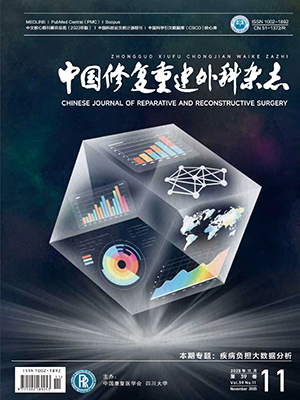Objective To observe the effect of radiofrequency ablation technology for the treatment of infected wounds in minipigs. Methods Infected wounds of full-thickness skin defects (about 6.15 cm2/wound) were prepared in 8 6-month-old minipigs (weighing, 30-35 kg) using the method of Davis et al. The 160 wounds were randomly divided into 4 groups (n=40). Infected wounds were debrided with the radiofrequency ablation technology in group A, with the electric knife in group B, and with the scalpel in group C; no treatment was done in group D as a control. The healing rate, healing time, and tissue filling rate were observed; bacterial quantitative examination and histological examination were done at 0, 2, 7, and 14 days after operation. Results All infected wounds were successfully established after 48 hours when Staphylococcus aureus dilution were inoculated. The wounds after radiofrequency ablation technology treatment were fresh and flat with slight bleeding; the healing time of group A was significantly shorter than that of groups B, C, and D (P lt; 0.05), and the healing rate of group A was significantly higher than that of groups B, C, and D at 7 and 14 days after operation (P lt; 0.05). The tissue filling rate of group A was significantly higher than that of groups B, C, and D at 2 days after operation (P lt; 0.05); the tissue filling rates of groups A, B, and C were significantly higher than that of group D at 7 and 14 days after operation (P lt; 0.05). At 0, 2, 7, and 14 days, there were significant differences in the bacterial count per gram tissue among 4 groups (P lt; 0.05), the order from low to high was groups A, B, C, and D. The histological observation showed that the surface of wound was smooth in group A at 0 day, and group A was better than the other groups in wound healing; at 2 days, some exudates were observed in 4 groups, but it was least in group A. There was inflammatory cell infiltration in various degrees in 4 groups at 7 and 14 days; it was lightest in group A with thick epithelium and dense collagen bundles, followed by groups B and C, and it was severe in group D. Conclusion The radiofrequency ablation technology can effectively remove the necrotic tissues of infected wounds, remarkably reduce the number of bacteria, improve the healing rate, and shorten the healing time of wounds.
Citation: YANG Rungong,ZUO Tantan,ZHU Jialiang,ZHONG Hongbin,WU Kejian,HOU Shuxun.. EXPERIMENTAL STUDY ON RADIOFREQUENCY ABLATION TECHNOLOGY FOR TREATMENT OF INFECTED WOUNDS IN MINIPIGS. Chinese Journal of Reparative and Reconstructive Surgery, 2013, 27(9): 1110-1115. doi: 10.7507/1002-1892.20130243 Copy
Copyright ? the editorial department of Chinese Journal of Reparative and Reconstructive Surgery of West China Medical Publisher. All rights reserved




